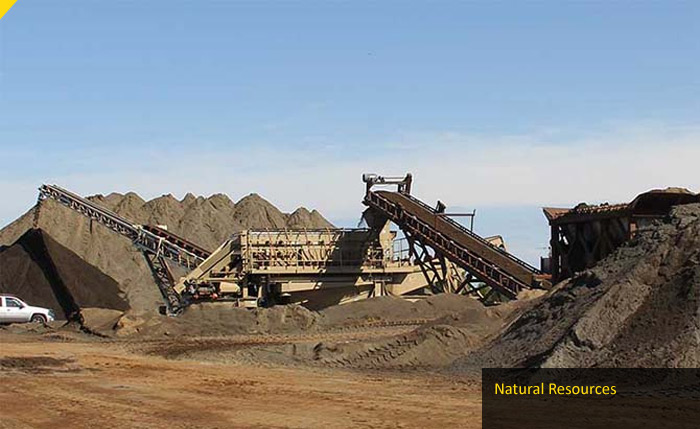

According to the U.S.G.S., in 2014 12 States each produced more than $2 billion worth of nonfuel mineral commodities – Arizona was number one. In fact Arizona produced over $8 Billion worth of non-fuel minerals in that year. Neighboring states, Nevada, Utah, California, and Colorado were 2nd, 5th, 6th and 7th respectively. In the same year, Arizona was 7th in the nation for production of construction aggregates – sand and gravel; crushed stone.
Arizona is a major producer and consumer of aggregates materials – consistently one of the top 10 producing states in the country and often in the top five. Construction aggregates are mined from private, state, federal and tribal land tenures in Arizona. Historically the most significant quantities of construction aggregates have come from the Salt / Gila, Agua Fria and Hassayampa corridors in the Phoenix metro area and the Santa Cruz River corridor in the Tucson metro area. There is still major production in these corridors from resources with varying amounts of remaining resources.
There are good options for construction aggregate resources near the metro market areas from alluvial deposits and crushed rock / mineral aggregates sources. Some of these tracts are currently used for irrigated agriculture. In many cases aggregate mining and processing facilities exist alongside ongoing farming.
In the U.S. Arizona production ranks:
![]() 1st in Pumice and Pumicite
1st in Pumice and Pumicite
![]() 3rd in Perlite
3rd in Perlite
![]() 4th in Zeolites
4th in Zeolites
![]() 6th in Dimension Stong
6th in Dimension Stong
![]() 10th in Lime
10th in Lime
Many industrial minerals fall somewhere in between. For construction aggregates and industrial minerals the distance the in-place resource can be from point of use (and the material can still be economic) may be increased by a number of factors including access to rail or water transport – or when local supplies are constrained by physical limitations or regulatory hurdles.
Arizona is known as the Copper State for good reason – we are the leading copper producing state in the U.S. It’s worth noting that some producing copper mines in Arizona also have meaningful molybdenum (moly) silver and gold production. Arizona is 3rd in the nation in molybdenum production and 7th in silver production. Arizona mines currently produce, or have produced, rare earth minerals, manganese, uranium, vanadium, zinc, lead, beryllium, tungsten, coal and at least 18 varieties of industrial minerals.
Potential major copper mines on the horizon:
There are exploration, early stage, idled and producing copper and other metallic mineral properties in Arizona, some with relatively well defined ore bodies. Metallic mineral resources in various stages of permitting and development are occasionally available for purchase, lease (often a net smelter royalty structure) or joint venture. But see caveat at the end of the Minerals section.
Split Estates Including Severed Mineral Rights, Private State and Federal and Mineral Reservations
Split estates are common in the checkerboard lands in northern Arizona lands – and in checkerboard tenures in other western states. The checkerboard configurations were the result of land granted to the railroads – every other section in many areas – from which the minerals were reserved when the surface estate was conveyed.
Also, a common practice (especially in states where “mineral” tends to mean hydrocarbons) is for sellers of surface estates to keep half the mineral rights they received when they acquired the property. The next surface owner does the same thing when they sell and so on – resulting in increasingly small fractional ownerships of the mineral estate – ½, ¼, and so on.
Mineral rights severed from the surface estate may be segregated or fractionalized (or both). For example, one entity may own the rights to all metallic minerals while the rest of the mineral rights belong to someone else. Or the hydrocarbons may be owned by several different individuals or entities – say four, each owning a ¼ interest – while the remaining mineral estate is owned by a fifth individual. Mineral estates may also be delineated by depth from the surface, e.g., all minerals from a depth of 100’ below the surface.
Points of contention in western states regarding split estates often include which estate is dominant under the applicable law(s) in a given jurisdiction and often, which minerals are included in a general mineral reservation in a deed of conveyance. There is a fair amount of case law related to these issues and there have been some IBLA decisions as well. Some of these specifically address whether construction aggregates / sand and gravel are included in a general mineral reservation.
One reference on the subject that serves as a pretty good primer for federal and private splits estates is Surface Tension The Problem of Federal / Private Split Estate Lands by Andrew C. Mergen 33 Land & Water L. Rev. 419 (1998) © University of Wyoming
In some cases, severed private minerals may be consolidated with the surface estate though a purchase. Severed federal minerals may sometimes be unified with private surface through mechanisms including exchanges and Section 209 mineral conveyances. Private, state and federal (leaseable or saleable) minerals may be secured for production purposes through royalty based leases.
I have worked on a variety of mineral issues in Arizona and neighboring states including market royalty rates, mining lease structures, material valuation methodologies and large tract split estate land actions. Among other mineral projects, I was responsible for the Arizona and California Statewide Mineral Commodity Royalty Study and Analysis reports for the Department of Interior Bureau of Land Management.
If you are a market participant looking to buy, lease or sell a producing mineral property or mineral resources, including construction aggregates and industrial minerals; if you have mineral resources you would like to sell or lease; or if you need to address a split estate issue in a land action in Arizona or a neighboring state, I can probably help. Info@StrategicSiting.com